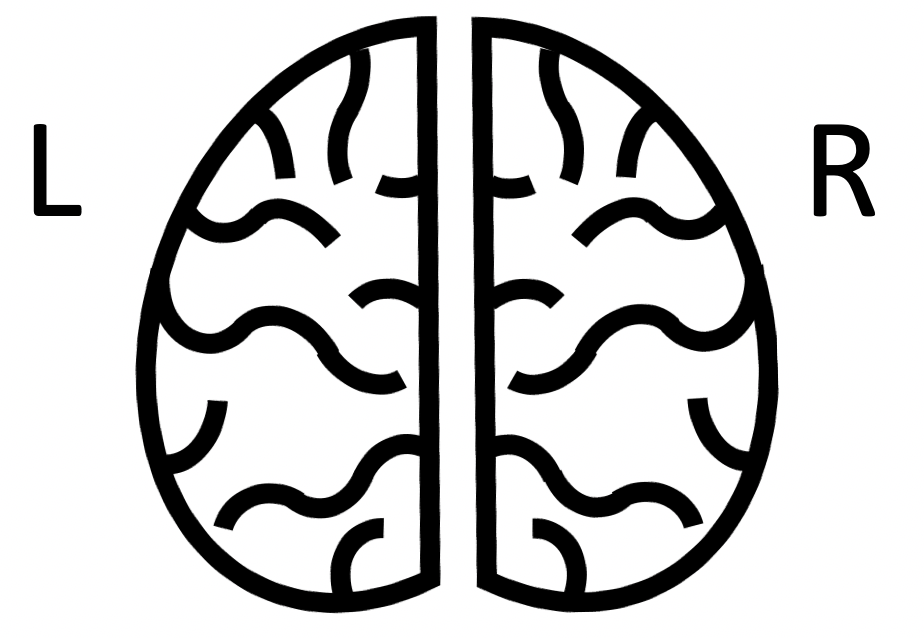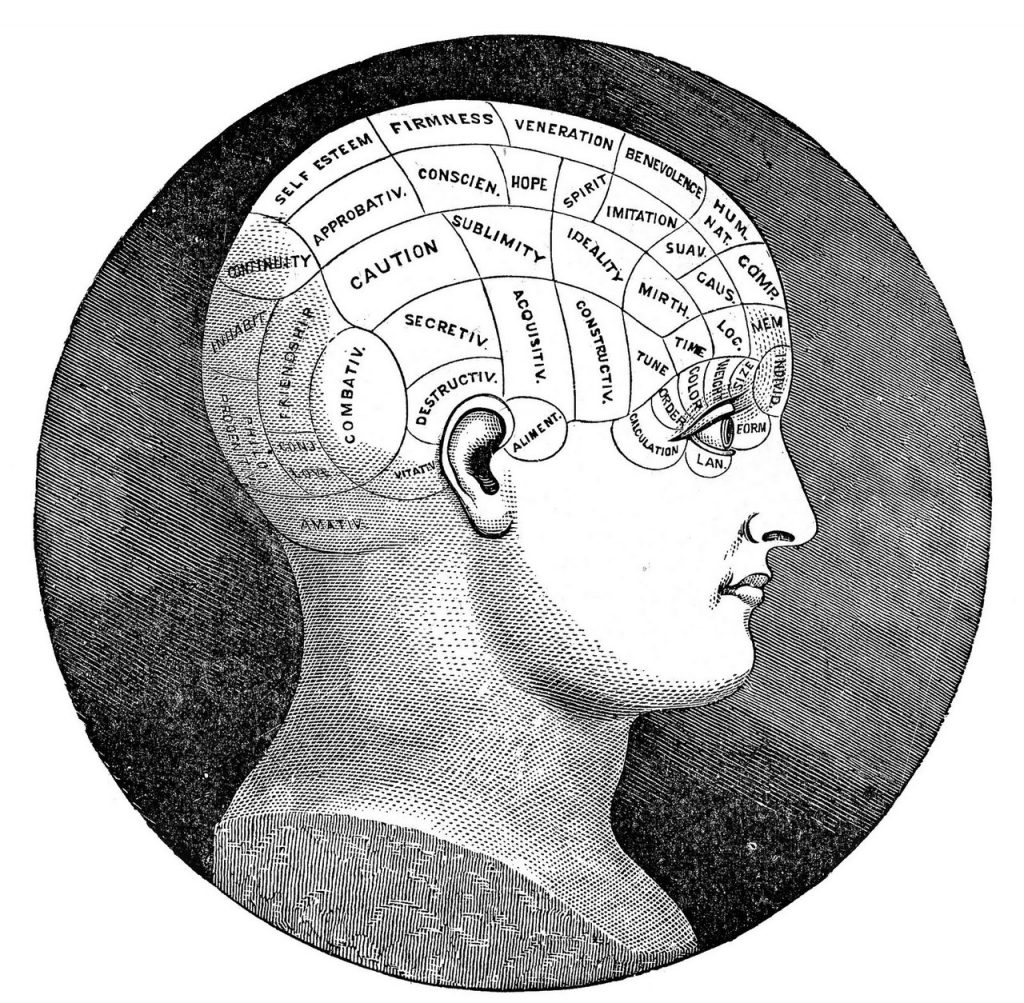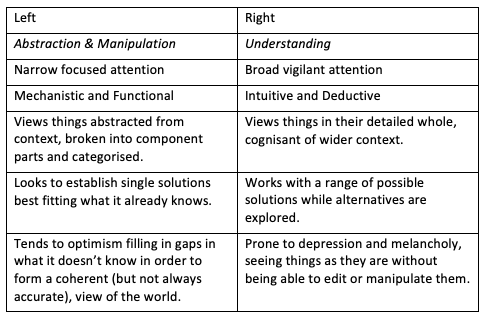How the different hemispheres of the brain interact and what this might teach us about architects and engineers.

The two hemispheres of our brain view our world differently, and when it comes to the business of thinking, they do this differently as well. The left is good at the manipulation of data dealing well with procedural tasks like sorting, abstracting & categorising, it sees the world around us in component details to be managed. The right on the other hand is good at the structural aspects of the data, i.e. how those different components go together, it understands things like music and the significance of words not said, as well as said in a conversation, it is able to see big picture complexity and recognise the inherent patterns within it.
My PhD is interested in how brains work in the field of design, particularly in design relating to buildings and the thinking of architects and engineers. At first glance, there are strong parallels between the two hemispheres of the brain, and architects and engineers. Engineers tend to deal with many left side oriented tasks, those requiring good abstraction and logic skills, tasks often involved in making the technical and detailed aspects of a project work. Architecture on the other hand tends to work with visual skills, emotive and big picture aspects of projects looking after the patterns within the overall. Engineers left : Architects right. The reality as it turns out is more complicated.
While the different thinking strengths in the hemispheres of our brains has been understood for some time, we are constantly learning more about how they interact to form ‘one mind’. Ian McGilchrist writes in his book dealing with the struggle for dominance between the hemispheres ‘The Master and his Emissary’, that: ‘ there is almost certainly nothing that is confined entirely to one or the other’. We require both hemispheres to do virtually all that we do.
A Jungian psychologist colleague (and co-supervisor for my PhD), Kaya Pripc likened it to walking. The fact that a person might start out with their right foot may show a predisposition for left hemisphere type thinking, but we need both feet working together to successfully walk.
Our brains are a great case study of how two disparate, individualistic thinkers work successfully together as one. The mechanics of the relationships offer lessons for the design of buildings, and how different members of design teams (such as architects and engineers), might better work together as one.
The Value of Difference
One of the most surprising aspects to me of the left/right hemisphere relationship is that of the value of maintaining difference. It turns out that ensuring a separation between the two hemispheres of our brains is vitally important:
Intuitively one might think that as the brain evolved and grew larger, the connections between the two hemispheres would also evolve and grow more numerous, the two sides becoming more and more connected. The opposite is in fact the case. As our brains have evolved the connections, indicated through the size of the corpus collosum (The corpus callosum is the thin layer of tissue that divides and connects the two hemispheres our brains), appear to have decreased rather than increased (Janke & Steinmertze, 2003).
Our brains have evolved over time to encourage further separation between the hemispheres, not less. This separation emphasises and cultivates the differences in their ways of thinking, it is known as lateralisation and it is an important part of how the brain works.
For a start it allows each hemisphere to deal with the tasks it is best suited to deal with. The left is good at maths, let it do the mathematical work, the right at emotion, let it interpret emotions.
Separation and duality also enhance outcomes through the use of contrast. A lot of how we perceive the world is based on difference, we may find it hard to gauge the weight of an object we hold in one hand for instance, but we are very good at comparing it with another weight held at the same time in our other hand. The contrast provided of one against the other allows us to focus our perception and judge.
This fits well with the realms of design. Design at it’s core is all about differences. Schon (1992), refers to the ‘see, draw, see’ process where a designer ‘sees’ a current state, ‘sketches or draws’ something different, and then ‘sees’ again reassessing whether the new state has improved or not. We rely on differences to be able to perceive and judge, and this allows us to move things like a design process forward.

Creativity
The right hemisphere of our brains is often credited as the source of our creative thinking because of its big picture view and the access it has to the full spectrum of available possibilities. It is able to see everything in front of it and recognise the patterns that exist to create possible connections and outcomes. Studies have been carried out that support this, finding that creativity often increases after a left brain strokes, when the left hemisphere is effectively disabled or switched off.
This is only half the story however.
McGilchrist (2010) goes on to observe that at the core of creativity is the union of things that are separate (and different), and that this is one of the main functions of the corpus callosum. The corpus callosum divides and connects the two hemispheres our brains and its’ job in controlling interactions is a significant one in regard to creativity. This appears to be borne out through studies that found that the ‘division of the corpus callosum does impair creativity’ (Bremer, 1958; Bogen & Bogen, 1988; Bogen & Bogen 1999).
While it is likely therefore that the right hemisphere has a degree of internal capacity for creativity, it would appear that the full creativity of the brain is not realised until both hemispheres work together through the corpus callosum.
Drawing parallels with building design, while the architects big picture view of the project likely trumps the engineers more detailed focus in terms of providing opportunity for generating creative solutions, stopping there restricts creativity to a one sided affair, the solutions coming from the ‘union of differences’ between the two remaining untapped.
Importantly, given rising energy costs and the need to combat climate change, it is the building solutions we need most, the well designed technically performing buildings that will be lost should we ignore the creative potential available from this ‘union of difference’ between architects and engineers.
Degree of Control
‘Psychologist Sir Charles Sherrington, observed a hundred years ago that one of the basic principles of sensorimotor control is what he called ‘opponent processors’ (Sherrington 1906). Adjustment of one of two opposing forces allows for increased refinement or delicacy in control. Many neuroscientists believe that the brain operates in a similar fashion as a ‘system of opponent processors’ (Marcel Kinsbourne, 1978). Kinsbourne points to three such oppositional brain pairings… In addition ot he left and right of the hemispheres, there is also the ‘up/down’ of the higher order cortex with the more basic subcortex, and the ‘front/back’ of the frontal lobes to posterior cortex.
It is not hard to see this ‘refinement through balance’ in action within design teams. One practitioner’s unbridled enthusiasm for a particular course of action is often tempered by another’s recognition of the consequential effects impacting the bigger picture for instance.
Design can be thought of as a process that balances sets of different, and commonly opposing, disciplinary forces. Each discipline competes for its own place in a project and in doing so keeps the other honest, giving up only as much as it is able to, or deems acceptable, in coming up with a final combined design outcome.
Some thinking characteristics between Left and Right

Winner Takes All
The hemispheres of our brain also operate on a winner takes all premise (Ornstein). When a particular hemisphere is better suited to a task than the other, say in a 80/20 split, then the better suited hemisphere ends up taking all of the processing, not just that portion it is ideally suited to.
In the case of design this is true also, if an individual designer has particular strengths they are usually given responsibility for designing all of the portion of a building relating to those strengths. This works well for the 80% of the design well suited to their area of expertise, the outcomes for the remaining 20% however may be more questionable.
McGilchrist points out that once a hemisphere has dealt with something once, it will be more than likely be sent any similar tasks in the future. The hemispheres, and in our case the designers, begin to broaden their remits, perhaps without a good basis of natural skillset (or education), on which to do so. In the case of design, the devil is often in the detail, it is well worth remembering to pay some attention to the 20 as well as the 80 in assessing design ideas that are to be adopted.
Reconciling Reality.
The different thinking natures of the left and right hemispheres provides each with its own view of the world and these views are rarely consistent. They effectively create two realities.
The left hemisphere has a tendency to construct its own view, formulating an abstracted picture often based on what it has known before. It denies any discrepancies in the picture that do not fit, and in fact in a process called confabulation it actually makes up new information to fill the gapsb that result. The final consistent picture it develops is not always in agreement with reality.
The right hemisphere on the other hand is unable to deny these inconsistencies seeing the hard realities exatly as they exist. As McGilchrist describes it, the right ends up constantly ‘playing devils advocate’ in an opposing role to the left.
In the interests of efficiency and moving forward in this strained relationship between two potentially different realities, at times the left hemisphere even goes to the extent of blocking out right brain activity to push it;’s reality through and get its own way (McGilchrist, 2010).
The lesson in design is one of being cogniscant of the interactions going on. Both roles are important, the left brains confabulation is a form of ‘executive decision’ making that is required to cut across some of the design concerns of others in order to move forward. The Right hemispheres warnings however are potentially important (and reflective of reality), and should not be ignored without conscious consideration. Perhaps more important to note is that it is entirely possible that many right brain type concerns are being suppressed, it might take some conscious effort to uncover them and give them an avenue to be aired.
Emergent (Transcendent) Thinking
As complex as we understand them to be, it is possible that the interactions between the two hemispheres of our brains may be even more important than we know, extending even to giving rise to the very consciousness that is our being.
Marie Banich, Director of the Institute of cognitive science at Boulder, Colorado, suggests that “interhemishperic interaction has important emergent functions – functions that cannot be derived by the simple sum of its parts”.
Successful buildings and the designs behind them often work in this way as well. Different components combine and interact to produce something different again, something that often surprises and transcends the sum of the original parts.
This transcendence of component parts should be one of the goals of all design thinking and it seems that successfully working with the differences between us may be keys to making it happen.

Two Brains are Better than One.
Music is a right brain strength. This is because the notes mean nothing on their own, it is the connection between them, the pauses and patterns that makes them into music.
It is unsurprisingly then learning music is a right brain orientated activity. What is surprising is that this is only applicable to amateur musicians. Professional musicians tend to use far more left brain in appreciating and dealing with music. McGilchrist postulates that this maybe because they have moved beyond the innate skills of the right to understand the technical basis of music, the non-emotional left brain thinking structure required to achieve certain musical ends.
This is true of the upper echelons of a number of activities including those in the left as well as the right, mathematics for instance is a left brain strength, it benefits however at the higher levels through right brain activity.
To be good at something, it seems you need to use the side of your brain best suited to the task at hand, but to be really good, you need both.
Conclusion
Our brains are made up of two distinct hemispheres each with its own distinctive way of thinking. They deal with the world around them on the basis of two ‘coherent and possibly irreconcilable sets of values’ (McGilchrist 2010).
The parallels with different disciplines within design teams is strong. Architects, engineers, clients, and project managers all have different natures of thinking, different world views and different sets of values peculiar to themselves. All of these contribute to their behaviours, what is key in acheiving good design perhaps is getting them to collaborate and build off of each others strengths to transcend their limitations to produce a building that is greater than the sum of its’ component parts.
There are many lessons we might take from how our brain works in achieving this.
The foremost of these lessons is that differences are key, they are to be valued and highlighted, we should not gloss over them and ignore them but consciously place them side by side instead, to interact. By doing so we maximise or chances of creating something that transcends and surprises as an outcome.
References:
Bronwell, Simpson, Bihrle et al., 1990, Tucker & Williamson, 1984
Kinsbourne, M. (Ed.). (1978). Asymmetrical function of the brain. Oxford, England: Cambridge U Press.
McGilchrist, I. (2010). The master and his emissary, the divided brain and the making of the western world (ISBN 978-0-300-18837-0). Newhaven and London. Yale University Press.
Rogers, L. J. & Andrew, R.J. Comparative Vertebrate Lateralization, Cambridge University Press, Cambridge, UK, 2002.
Richards & Cchiarello, 1997.
Images:
Left/Right Brain (and cover image) – illustration by author.
‘Different parts of our brain think differently’ – https://thegraphicsfairy.com/vintage-clip-art-antique-phrenology-head/
Engineering and Architecture combining to mess with the minds of penguins.
(Penguin Pool, London Zoo – Source www.Arch20.com)
v01.1 14.02.19